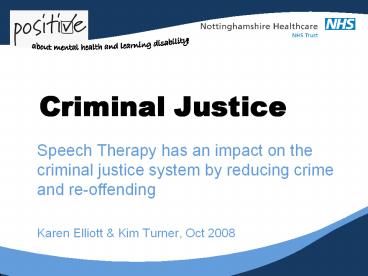Criminal Justice - PowerPoint PPT Presentation
1 / 20
Title:
Criminal Justice
Description:
Speech Therapy has an impact on the criminal justice system by reducing crime ... children with behavioural disorders Cohen et al (1993) Valance et al (1998) ... – PowerPoint PPT presentation
Number of Views:61
Avg rating:3.0/5.0
Title: Criminal Justice
1
Criminal Justice
- Speech Therapy has an impact on the criminal
justice system by reducing crime and re-offending
- Karen Elliott Kim Turner, Oct 2008
2
Origin of the myth
- Developing oral communication and productive
thinking skills in HM Prisons - 21 of the ESB sample were reconvicted in the 1st
year after release compared with 44 nationally
(a 52 reduction) - BBC News Communication skills cut
re-offending - Linked these figures directly to Speech and
Language Therapy
3
False Origin True Myth
- Clearly the original evidence is flawed
- BUT
- There is evidence linking language disorders with
future offending - There is evidence about the high rates of
communication difficulties in the offender
population
4
False Origin True Myth cont
- There is evidence for the benefit of Speech and
Language Therapy reducing the impact of these
communication difficulties - Leading to improved access to treatment and
rehabilitation programmes - Decreased social isolation and increased
employability - These all indicate that Speech Therapy has an
impact on reducing crime and re-offending
5
Reducing Crime
- SLT Interventions with vulnerable children
6
Early Language Development and Future Criminal
Behaviour
- Link between SLI and later conduct problems
Hooper et al (2003) - Boys with a language impairment were rated higher
on delinquency scales than controls Brownlie et
al (2004) - Higher rate of language problems amongst children
with behavioural disorders Cohen et al (1993)
Valance et al (1998)
7
Bercow Report
- The Bercow Review of Services acknowledged the
links between language impairment and future
offending - If a child does not benefit from early
intervention, there are multiple risks of lower
educational attainment, of behavioural problems,
of emotional and psychological difficulties, of
poorer employment prospects, challenges to mental
health and, in some cases, of a descent into
criminality. (pg8)
8
Efficacy of SLT Treatment for Children with
Expressive Language Delays
- The Hanen Program for parents has demonstrated
significant improvements in expressive language
skills for children with severe expressive
language delays Girolametto et al 1996b - Gibbard (1994) demonstrated significantly greater
gains in the expressive language skills of the
experimental group compared to the control group
9
Efficacy of SLT Treatment for Children with
Receptive Language Delays
- Pre-school language support provided for short
periods twice-weekly was demonstrated to enhance
comprehension skills Dockrell, Stuart King,
2006 - Adolescents with language and communication
problems showed significant improvements in
their receptive vocabulary, recalling sentences
and non-literal comprehension Joffe, 2006
10
Efficacy of SLT Treatment for Children with
Pragmatic Language Problems
- Intervention produced a signal for change in
pragmatics and/or language behaviour in all
children Adams et al 2006
11
Reducing Re-Offending
- The Role of SLTs in YOIs and Prison Settings
12
Level of Communication difficulties among the
Offender Population
- Incarcerated adolescent boys have displayed
higher levels of language deficits Davis et al
(1991) - Young Offenders (17-20yrs) had an average age
equivalent of 1204 on language assessment and
1101 on vocabulary Pryor (1998) - 55 of males (15-17yrs) in a YOI scored poor or
below on Test of Adolescent and Adult Language
compared to 9 of controls Bryan (2007) - Youth Offenders in Puerto Rica demonstrated
deficits in language skills and pragmatic
functioning Linares-Orama (2005)
13
Offender treatment
- Basic Skills Training
- Offending Behaviour Programmes
- Drug Misuse Programmes
- Educational Courses
- Vocational Courses
- Enhanced Thinking Skills
- Reasoning and Rehabilitation
- HM Prison Service Reducing Prisoner
Re-Offending (2002)
14
SLT Role in Improving Access to Treatment
- Pre-therapy
- Build confidence in communication skills
- Teach specific vocabulary
- Address barriers to group-working
- Indirect
- Informing facilitators of specific difficulties
- Modification of environment
15
Pathways Out of Re-Offending
- Accommodation
- Education, training and employment
- Health
- Drugs and alcohol
- Finance, benefit and debt
- Children and families
- Attitudes, thinking and behaviour
- National Reducing Re-Offending Delivery Plan
(2005)
16
SLT Role in decreasing risk factors
- Employment Hall et al (1999) prisoners are
rarely equipped with the skills that employers
value highly namely, oral communication and
interpersonal skills - Children and families Social isolation is known
to be a risk factor for offending and
re-offending (Every Child Matters)
17
- Health Finance, Benefit and Debt
- Instilling confidence in their communication
skills to access the required services - Adaptability in communication modes/style in
order to ensure appropriate and effective
interactions with services - Language skills to process and absorb advice and
assistance - Drugs and Alcohol Attitudes, Thinking and
Behaviour - Pre-therapy and indirect work as discussed
earlier to access programmes
18
Conclusions
- Speech and Language Therapy interventions with
children can reduce the impact of their speech
and language impairments consequently reducing
their risk of developing behavioural and conduct
problems and therefore reducing the risk of
offending - Speech and Language Therapy interventions with
offenders could result in improved access to
Treatment groups, improved confidence in
communication skills and therefore a reduced risk
of re-offending
19
Conclusions cont
- Therefore we would assert that Speech and
Language Therapy has an impact on the criminal
justice system by reducing crime and re-offending
20
Abolishing the Myth Revealing the Facts
- Developing an evidence base
- Are children treated for SLI less likely to
develop conduct disorder than those who do not
receive treatment - Does pre-therapy reduce drop-out rates and
improve outcomes of offender treatment programmes































